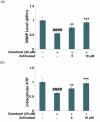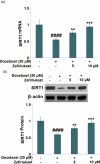Zafirlukast ameliorates Docetaxel-induced activation of NOD-like receptor protein 3 (NLRP3) inflammasome, mediated by sirtuin1 (SIRT1) in hepatocytes
- PMID: 34787067
- PMCID: PMC8810069
- DOI: 10.1080/21655979.2021.2005895
Zafirlukast ameliorates Docetaxel-induced activation of NOD-like receptor protein 3 (NLRP3) inflammasome, mediated by sirtuin1 (SIRT1) in hepatocytes
Abstract
Docetaxel-associated liver injury has become a serious public health problem, resulting in therapy discontinuation, liver failure, and death. Zafirlukast is a typical leukotriene receptor antagonist used for prophylaxis and chronic treatment of asthma. In this study, we investigate whether treatment with Zafirlukast could alleviate Docetaxel-induced cytotoxicity in hepatocytes. Our results indicate that Zafirlukast mitigated Docetaxel-induced toxicity in LO-2 hepatocytes. Firstly, Zafirlukast reduced the production of 8-hydroxy-2p-deoxyguanosine (8-OHdG) and increased the levels of reduced glutathione (GSH) against Docetaxel. Secondly, Zafirlukast elevated the levels of mitochondrial membrane potential (ΔΨm) and adenosine triphosphate (ATP). Thirdly, Zafirlukast prevented Docetaxel-induced release of lactate dehydrogenase (LDH) and increased cell viability of LO-2 hepatocytes against Docetaxel. We also found that Zafirlukast ameliorated Docetaxel-induced apoptosis by reducing Caspase-3 and Caspase-9 activity. Mechanistically, our results demonstrate that Zafirlukast inhibited the activation of NOD-like receptor protein 3 (NLRP3), mediated by SIRT1. Based on these findings, we conclude that the administration of Zafirlukast might have a protective effect against Docetaxel-induced cytotoxicity in hepatocytes.
Keywords: Docetaxel; LDH; SIRT1; Zafirlukast; hepatocytes.
Conflict of interest statement
No potential conflict of interest was reported by the author(s).
Figures







Similar articles
-
Zafirlukast ameliorates lipopolysaccharide and bleomycin-induced lung inflammation in mice.BMC Pulm Med. 2024 Sep 16;24(1):456. doi: 10.1186/s12890-024-03273-6. BMC Pulm Med. 2024. PMID: 39285346 Free PMC article.
-
Anagliptin ameliorates high glucose- induced endothelial dysfunction via suppression of NLRP3 inflammasome activation mediated by SIRT1.Mol Immunol. 2019 Mar;107:54-60. doi: 10.1016/j.molimm.2019.01.006. Epub 2019 Jan 17. Mol Immunol. 2019. PMID: 30660990
-
Activation of NLRP3 inflammasome in hepatocytes after exposure to cobalt nanoparticles: The role of oxidative stress.Toxicol In Vitro. 2020 Dec;69:104967. doi: 10.1016/j.tiv.2020.104967. Epub 2020 Aug 14. Toxicol In Vitro. 2020. PMID: 32805375
-
Luteolin ameliorates LPS-induced acute liver injury by inhibiting TXNIP-NLRP3 inflammasome in mice.Phytomedicine. 2021 Jul;87:153586. doi: 10.1016/j.phymed.2021.153586. Epub 2021 May 5. Phytomedicine. 2021. PMID: 34044253
-
Zafirlukast.2019 Jun 4. LiverTox: Clinical and Research Information on Drug-Induced Liver Injury [Internet]. Bethesda (MD): National Institute of Diabetes and Digestive and Kidney Diseases; 2012–. 2019 Jun 4. LiverTox: Clinical and Research Information on Drug-Induced Liver Injury [Internet]. Bethesda (MD): National Institute of Diabetes and Digestive and Kidney Diseases; 2012–. PMID: 31643251 Free Books & Documents. Review.
Cited by
-
A bioinspired and high-strengthed hydrogel for regeneration of perforated temporomandibular joint disc: Construction and pleiotropic immunomodulatory effects.Bioact Mater. 2022 Jul 20;25:701-715. doi: 10.1016/j.bioactmat.2022.07.006. eCollection 2023 Jul. Bioact Mater. 2022. PMID: 37056268 Free PMC article.
-
Zafirlukast ameliorates lipopolysaccharide and bleomycin-induced lung inflammation in mice.BMC Pulm Med. 2024 Sep 16;24(1):456. doi: 10.1186/s12890-024-03273-6. BMC Pulm Med. 2024. PMID: 39285346 Free PMC article.
References
-
- Chalasani NP, Hayashi PH, Bonkovsky HL, et al. ACG clinical guideline: the diagnosis and management of idiosyncratic drug-induced liver injury. Am J Gastroenterol. 2014;109(7):950–966. quiz 67. - PubMed
-
- Lee WM. Acetaminophen and the U.S. acute liver failure study group: lowering the risks of hepatic failure. Hepatology. 2004;40(1):6–9. - PubMed
-
- Velayudham LS, Farrell GC.. Drug-induced cholestasis. Expert Opin Drug Saf. 2003;2(3):287–304. - PubMed
Publication types
MeSH terms
Substances
LinkOut - more resources
Full Text Sources
Research Materials
